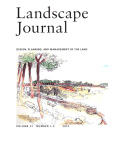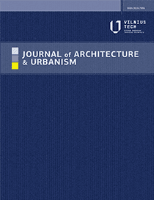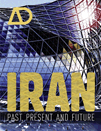
Landscape Architecture and Art
Scope & Guideline
Advancing Knowledge at the Intersection of Landscape and Art
Introduction
Aims and Scopes
- Sustainable Landscape Design:
The journal promotes research on sustainable practices in landscape architecture, focusing on ecological design principles, resource conservation, and innovative uses of materials. - Cultural Heritage and Historical Landscapes:
A significant emphasis is placed on the exploration and preservation of cultural and historical landscapes, including studies on historical architecture and the evolution of urban spaces. - Urban Design and Public Spaces:
Research in this area examines the design and functionality of urban spaces, highlighting the importance of public engagement, social interactions, and community-driven design in urban landscapes. - Digital Technologies in Landscape Architecture:
The journal explores the application of digital technologies in landscape design, including the use of GIS, parametric design, and digital fabrication techniques to enhance design processes. - Interdisciplinary Approaches:
There is a consistent focus on interdisciplinary methodologies that blend art, architecture, and landscape studies, fostering a holistic understanding of environmental design.
Trending and Emerging
- Circular Economy in Landscape Design:
There is an increasing focus on circular material use in landscape design, highlighting the importance of sustainability and resource efficiency in contemporary practices. - Community Engagement and Participatory Design:
Research on community engagement in urban experiments is gaining prominence, emphasizing the value of public involvement in creating sustainable urban environments. - Blue-Green Infrastructure:
A notable trend is the development and integration of blue-green infrastructure, which addresses urban flooding and promotes biodiversity, reflecting a growing awareness of climate resilience. - Digital and Parametric Design Innovations:
The exploration of digital technologies and parametric design methodologies is on the rise, showcasing a shift towards innovative design processes that enhance creativity and efficiency. - Health and Well-being in Landscape Architecture:
Emerging studies focus on the healing effects of nature and the design of environments that promote mental and physical well-being, underscoring the importance of health in landscape architecture.
Declining or Waning
- Traditional Landscape Techniques:
Research centered on traditional landscape techniques has diminished, likely due to a growing emphasis on modern, sustainable practices and technological advancements in the field. - Static Historical Analysis:
Papers that solely focus on static historical analysis of landscapes without consideration for contemporary relevance or application have become less frequent, as the journal seeks more dynamic and applicable research. - Regional Studies with Limited Scope:
Studies concentrating exclusively on specific regional landscapes without broader implications or connections to global trends are declining, indicating a shift towards more universal themes in landscape architecture.
Similar Journals

Interiors-Design Architecture Culture
Fostering Dialogue Between Design, Culture, and SpaceInteriors - Design Architecture Culture is a prominent academic journal dedicated to exploring the multi-dimensional relationship between interiors, design, and architecture, while also emphasizing their cultural significance. Published by Routledge Journals, Taylor & Francis Ltd, this journal serves as an essential platform for innovative research in the fields of architecture, cultural studies, and visual arts. The journal, which has been disseminating vital findings since its inception in 2010, plays a crucial role in fostering interdisciplinary discourse, and it currently holds a Q4 rank in Architecture and Cultural Studies, alongside a Q3 rank in Visual Arts and Performing Arts. Though it operates under a traditional access model, the journal's rigorously peer-reviewed articles are vital for researchers, professionals, and students alike, contributing to an enriched understanding of how interior spaces shape, and are shaped by, cultural dynamics. With an ISSN of 2041-9112 and E-ISSN of 2041-9120, the journal continues to make significant contributions to the academic discourse surrounding the design and cultural narratives of interior spaces.

Techne-Journal of Technology for Architecture and Environment
Exploring the Nexus of Technology and EnvironmentTechne - Journal of Technology for Architecture and Environment, published by FIRENZE UNIV PRESS, is an important academic platform that bridges the gap between technology and architecture while addressing the evolving environmental challenges of our time. Established in 2015, this journal provides a forum for innovative research and discussions that critically examine the intersections of architecture, urban studies, and construction engineering. With an impact factor indicative of growing recognition in its field, Techne encompasses a broad spectrum of studies, marking its presence in the Q3 and Q4 quartiles across various categories, including Architecture, Building and Construction, Education, and Health (Social Science). The journal is indexed in Scopus with varying ranks, showcasing its increasing relevance and influence among contemporary literature. Although it operates under a non-open access model, the journal ensures that its scholarly contributions are accessible through institutional connections, making it a vital resource for researchers, professionals, and students seeking to advance their knowledge on the integration of technology in shaping sustainable architectural practices.

Landscape Journal
Bridging Environmental Science and ArchitectureWelcome to the Landscape Journal, a prominent publication in the field of Nature and Landscape Conservation, proudly brought to you by University of Wisconsin Press. Since its inception, this journal has strived to underpin the critical interplay between environmental science and landscape architecture, providing a platform for innovative research and comprehensive insights. With an ISSN of 0277-2426 and an E-ISSN of 1553-2704, the Landscape Journal is indexed in leading academic databases and recognized with a 2023 Scopus Rank of #167, placing it in the 21st percentile among its peers. The journal operates from the heart of the United States, featuring converged years from 2009 to 2019 and again from 2021 to 2024, making it a reliable resource for ongoing dialogue in landscape studies. Although it currently does not offer open access, the Landscape Journal remains an essential resource for researchers, professionals, and students dedicated to understanding and enhancing our natural environments. As a Q3 category journal, it invites contributions that push the boundaries of landscape research while fostering environmental stewardship.

Frontiers of Architectural Research
Transforming Ideas into Architectural PracticeFrontiers of Architectural Research, published by KEAI PUBLISHING LTD, stands at the forefront of interdisciplinary scholarship, addressing contemporary challenges in the fields of architecture, urban studies, building and construction, and archaeology. Since its establishment in 2012, this open-access journal has rapidly gained recognition, achieving prestigious rankings in the 2023 category quartiles, including Q1 placements in both Architecture and Archaeology. With an impressive Scopus rank of #5 out of 354 in Archaeology and #10 out of 189 in Engineering - Architecture, it demonstrates its significant influence and contribution to advancing architectural research. Frontiers of Architectural Research embraces a broad scope that fosters innovative discourse and practical solutions, catering to a diverse audience of researchers, professionals, and students keen on exploring the intersection of culture, environment, and technology. By ensuring immediate access to research findings, the journal not only enhances the visibility of scholarly work but also encourages collaborative dialogues that shape the future of architectural practice.

Festival dell Architettura Magazine
Exploring the Intersection of Architecture and ArtFestival dell Architettura Magazine, published by FESTIVAL ARCHITETTURA EDIZIONI, is a distinctive Open Access journal dedicated to the realms of architecture, urban studies, and the visual and performing arts. Established with a vision to foster interdisciplinary dialogue, the journal has been a part of the academic landscape since 2013 and has converged its insightful contributions from 2018 to 2023. Despite being ranked in the lower quartiles in its respective categories—Q4 in Architecture and Urban Studies, and Q3 in Visual Arts and Performing Arts—this publication remains vital for emerging researchers and seasoned professionals alike, as it provides a platform for innovative ideas and practices from Italy and beyond. It serves as a key resource for those who wish to engage with contemporary architectural thought and cultural expressions, facilitating open access to research that highlights the intersections of space, society, and art.

Journal of Architecture and Urbanism
Shaping Tomorrow’s Urban LandscapesThe Journal of Architecture and Urbanism, published by VILNIUS GEDIMINAS TECH UNIV, stands as a pivotal resource for scholars and practitioners in the fields of architecture and urban studies. Since its inception in 2012, the journal has committed to advancing research and discourse on the design, planning, and functionality of urban environments, reflecting a dedicated focus on contemporary challenges in architecture and urbanism. With an impressive open access model implemented since 2018, it ensures that innovative research is accessible to a global audience, fostering collaboration and knowledge exchange. The journal boasts a commendable reputation, categorized in the Q2 quartile for Architecture and Q3 in both Geography, Planning and Development and Urban Studies as of 2023, while maintaining respectable Scopus rankings. Addressing key themes from sustainable design to socio-economic impacts on urban spaces, the journal aims to inspire new models and solutions that meet the evolving needs of growing urban populations. This is a must-read for anyone engaged in the intersection of architecture and urban development.

i2 Investigacion e Innovacion en Arquitectura y Territorio
Fostering interdisciplinary insights in architecture and territorial development.i2 Investigacion e Innovacion en Arquitectura y Territorio is a leading open-access journal published by the University of Alicante, dedicated to advancing research and innovation in the fields of architecture and territorial development. Since its inception in 2013, this journal has aimed to provide a robust platform for scholarly discourse, promoting interdisciplinary approaches that connect academic insights with practical applications in urban planning and environmental design. With its commitment to accessibility, the journal ensures that cutting-edge findings and case studies are readily available to researchers, professionals, and students alike, fostering collaboration and informed decision-making. As the landscape of architecture and geography continues to evolve, the i2 journal stands out as a crucial resource for enhancing knowledge and cultivating innovative practices in these dynamic fields.

Open House International
Pioneering Research for Sustainable Urban FuturesOpen House International is a distinguished peer-reviewed journal that serves as a vital resource in the fields of Architecture, Urban Studies, and Geography, Planning and Development. Published by Emerald Group Publishing Ltd, the journal circulates valuable insights and research findings that address contemporary challenges and innovations within urban environments. With an impressive 2023 Scopus ranking that places it in the Q2 category in Architecture and Q3 in Geography, Planning and Development, the journal is recognized for contributing significantly to scholarly discourse. Although it follows a traditional access model, the journal's commitment to curating high-quality content remains paramount. As it transitions into a new decade of publishing, from 2007 to 2024, Open House International continues to attract submissions that push the boundaries of knowledge in urban and architectural studies, engaging researchers, professionals, and students alike in the vibrant dialogue on the built environment.

ARCHITECTURAL DESIGN
Inspiring the Future of Visual Arts and ArchitectureARCHITECTURAL DESIGN, a leading journal published by Wiley Periodicals, Inc., serves as a vital platform for discourse in the fields of architecture and visual arts. With an ISSN of 0003-8504 and an E-ISSN of 1554-2769, this esteemed publication offers comprehensive insights into contemporary design practices and emerging architectural theories. Established in the United States and continuously evolving from 2002 to 2024, the journal has secured a prominent position with a Q3 status in Architecture and an impressive Q1 ranking in Visual Arts and Performing Arts as of 2023. Its Scopus rankings further affirm its relevance, with a percentile ranking of 82nd in the Visual Arts category. Although it does not currently offer Open Access options, the journal remains dedicated to disseminating high-caliber research and innovative design strategies that engage a diverse readership of researchers, professionals, and students alike. The contributions published within its pages are instrumental in shaping the discourse around architecture, making ARCHITECTURAL DESIGN an indispensable resource for anyone passionate about the built environment.

Boletin Academico-Revista de Investigacion y Arquitectura Contemporanea
Empowering Scholars to Transform Architectural Discourse.Boletin Academico-Revista de Investigacion y Arquitectura Contemporanea is a distinguished journal published by SIELAE & UNIV CORUNA, Fac Filologia, focusing on the interconnectivity of contemporary architecture, cultural studies, and visual arts. With an E-ISSN of 2173-6723, this open-access publication serves as an essential resource for researchers, academics, and professionals eager to explore innovative perspectives and methodologies in these dynamic fields. Spanning a commendable period from 2016 to 2023, the journal demonstrates a strong academic footprint, ranked in the Q2 category for both Architecture and Cultural Studies, and holds a prestigious Q1 ranking in Visual Arts and Performing Arts. With Scopus rankings reflecting its growing influence—particularly in Visual Arts and Architecture—Boletin Academico delivers a platform that is not only academically rigorous but also culturally relevant, encouraging discourse that shapes the future of contemporary architectural and artistic practices. The journal’s commitment to open access further enhances its appeal, ensuring that groundbreaking research is readily available to an extensive audience.